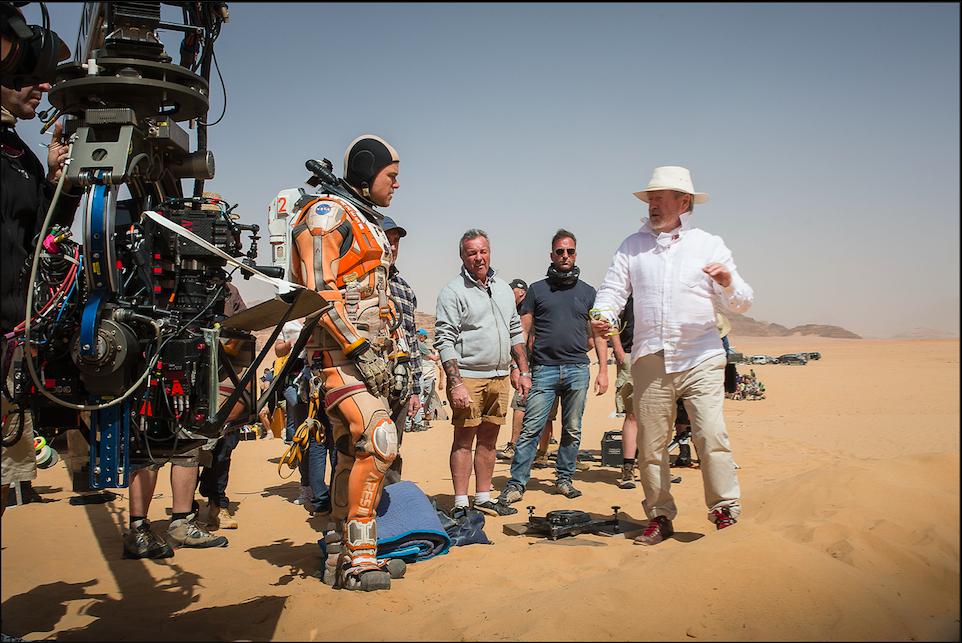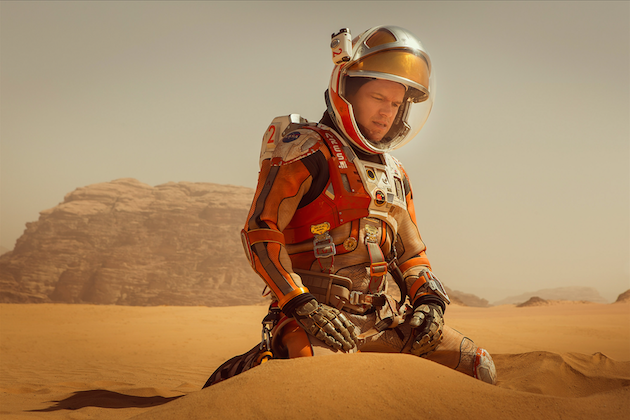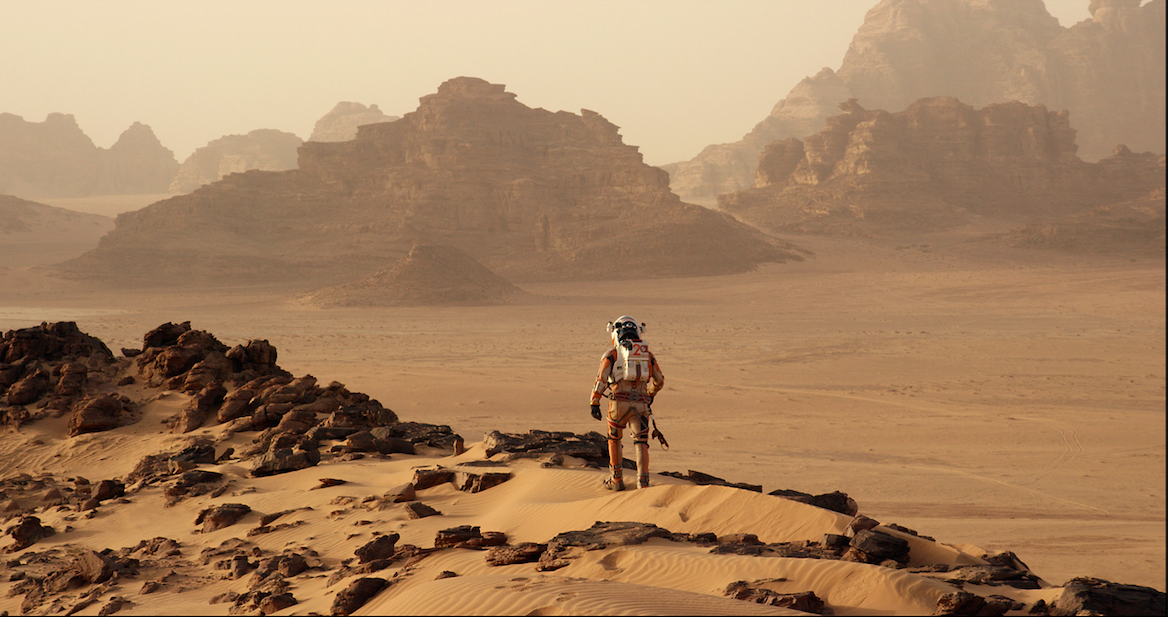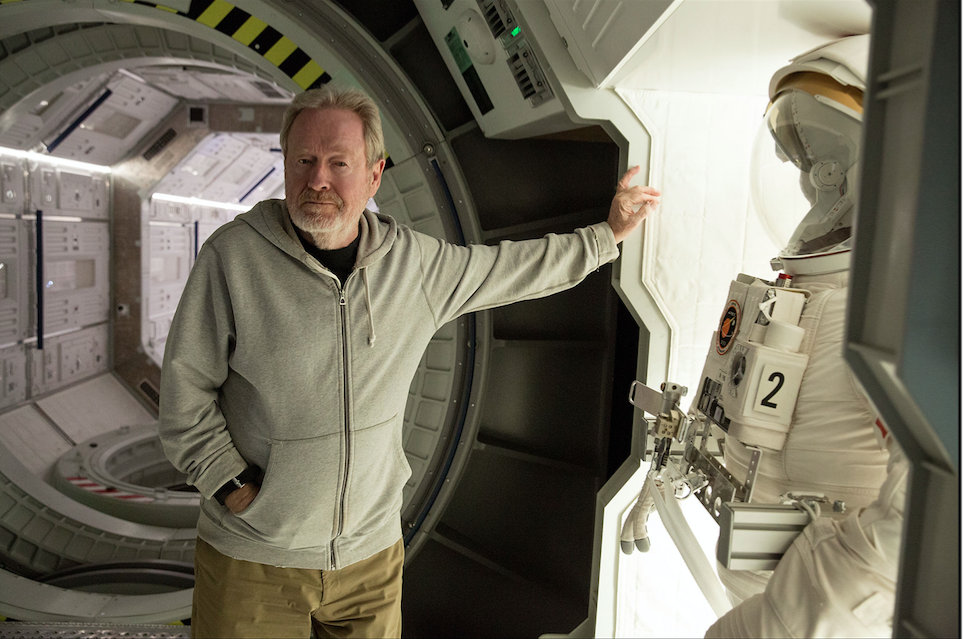The Martian’s VFX Supervisor on Creating Zero Gravity Without a ‘Vomit Comet’
As The Martian continues its impressive box office run and enjoys some early Oscar buzz, The Credits talks to Richard Stammers, the film's visual effects supervisor and a frequent collaborator with Ridley Scott, about the dual challenge of recreating the Mars landscape and simulating a convincing zero gravity environment without anyone having to get in a “vomit comet”.
You've worked with Ridley Scott before on films like Prometheus?
Yeah, Robin Hood was the first one and I guess was the really big one. He sort of got confidence in me, and asked me back for The Counselor. I did a bit of work on Exodus as well, and then The Martian has been the latest endeavor.
Why do you think you have such a good working relationship?
When we first worked together, I think I just came and got on with it. We connected fairly well, and I have a design and art background as well, that I think has some appeal. You eventually build up this sort of shorthand of understanding of what he means, and being able to interpret everything that he's trying to get from a visual effects shot.

I imagine that's probably a big part of your job as well, because obviously there's a huge technical component, but if you can't see what they're envisioning, then how can you realize it?
Yeah, you're absolutely right. There is a huge amount of technical knowledge as well, but I have to rely on teams of other people to work along with me, that have far more technical knowledge than I do. They're the ones that actually doing a lot of the work day to day. I have to creatively oversee it, and make sure that we are trying to get Ridley's vision onto screen. As you say, it's trying to interpret his wishes, his drawings, his scribbles, his sketches, and turn that into something fantastic on screen that he really likes. That's an incredibly important part of the work.
I'm assuming that's part of the fun of it, too?
Yes, absolutely. There's always that challenge like, "Well, are we going to go for this, or is it this?" Did he mean that?" Sometimes you get a drawing for something, and sometimes it's incredibly clear, and it's this beautiful sketch of exactly what he wants, and it's like, "That's it. That's what we're doing." When it comes to beautiful landscapes and things like that the views of Mars were no different, really, but we found a really great location to shoot it. Then he still wanted to make it different, and special by adding more to it.

You mentioned the location, you filmed some of it in Jordan, is that right?
That's right. We spent most of our time shooting actually in Budapest, in Hungary. The majority of the Mars stuff was actually shot on the giant green screen stage, one of the world's largest sound stages in the Korda Studios in Budapest. The backgrounds to that were based on the location that we went to at the end of the schedule, which was Wadi Rum in Jordan.

Because of the very compressed schedule we had, we had quite a short shoot, and a very, very short post schedule for a film like this. During our scouts of the locations before we started filming, we did a lot of texture photography, and pre-built the digital environment that we were later going to need for the shots, before we started shooting. On day one of our green screen stage shoot, we would be there with Ridley, and we had a pre-built Martian environment we were running on an iPad, so you could hold an iPad up, and turn it round, wherever you panned, it would show a full 360 degree picture of what it was going to be.
Very cool.
Yeah, so that was incredibly helpful. So we could say, "Look, Ridley, if you want to point the camera in that direction, you're going to see these mountains. If you go this way, we're going to see these mountains." We could line it up specifically and key the green screen out to give us a rough comp of what the shots would look like. It was really helpful for making sure the light quality was right. It's really hard to light something in a studio to look like natural, outdoor daylight. That was always a big challenge, especially for a stage so big.
Our director of photography (Dariusz Wolski) chose to light with, thankfully, one great big single light source, so we had consistent, even shadows, rather than multiple shadows, and never got into that feeling of looking studio lit.
For you, was that the biggest component in creating the Mars environment? What other elements required heavy visual effects?
It's interesting, the work in the film sort of divided up quite evenly. There was a large chunk of work that takes place on Mars: that was the majority of the work. We gave that work to MPC, a visual effects company, and they handled all the Mars surface work. Then we have a chunk of the film that takes place in space. We gave that work to Framestore, another company based here in London, who had experience with things like gravity. They were very well suited for doing the Hermes space ship, which was quite a big undertaking, just to build that as a space ship. So the scenes that relate to the Hermes in zero gravity mode means the space walks and things that happen in the final rescue, ended up being all of their work, because that takes place in space.
Are they actually ever in a zero gravity environment when they're filming those scenes?
No. All of our zero gravity moments are cheated with stunt wire work. We never did the sort of things that they did on Apollo 13, when they took them up in what they call the ‘Vomit Comet’, which gives the weightlessness. You get 40 seconds of weightlessness to perform a scene, and then go back up again and do it again. That would have been nice to have that kind of realism, that luxury of being able to shoot like that, but we have such massive sets. The corridor of the Hermes was probably 100 meters long, or something like that, so we've got the actors traveling down there, and we used a number of really interesting technology solutions to get their movement looking really right.
How did you resolve that?
We started with pre-visualization of animating out the scene, and getting the shots, knowing the shots that Ridley would like. Then from there, we ran the stunt team, who had sort of an overhead winch system that would carry the actors on four wires, down the length of the corridor, and could rotate them and angle them, and things like that. We were able to program their winch system based on our previews, so it would get the time exactly as what Ridley wanted in the shots. We also used a motion control that could squeeze into the narrowest spaces in the sets without bumping into anything, and move as soon as the actors had gone past. We got to this point where we had the stunt wire system, the camera, and rotating parts of the set all controlled through the same trigger.

Basically, if Jessica Chastain was floating along the corridor, she could always float past the camera at exactly the same time, never collide with it, and reach this rotating intersection, which goes off to the gravity wheel, and always exit in the right place at the right time, when the tube that she had to go into to exit was always there at the right place. It was this great synergy of all the technology sort of singing off the same song sheet.
It's kind of interesting solutions to problems and actually, in the end, everything could have been done manually. But you would have the problem of if not quite hitting the mark or getting something just right. You end up aborting a shot. We achieved everything with fewer takes, and it was all about just the actors knowing that every single time we did something, everything would be the same, and the only thing that would vary was their own performance.
When you're working on a film like Prometheus, where it's an invented world, versus something like this, where it does actually exist somewhere in the universe, what do you prefer?
To be honest, even with Prometheus, even though it’s a fantasy, to me, to try and get something as seamless and as beautiful as possible, I always try to find real reference of something. Just trying to call some real, tangible thing into any shot that we do. Obviously, that's slightly easier with Mars, because there are so many photographs of it, but still, even that was slightly intangible in the sense that all of NASA's photos, every single one of them has a slightly different color to it and has been treated in a different way. The way they process their images, it's like, Well, actually, are the skies gray, or are they green, are they yellow, are they kind of red?
In the end, it becomes this sort of subjective thing as well, depending on how you interpret things. In the same way that we dealt with the alien planet in Prometheus, it's still one of those slightly intangible things of like, Okay, how do we ground this in reality? What are the things that we can rely on to say, “That's real”. You're trying to find, at least at one point in a shot somewhere, where it feels kind of natural, and you can build upon that. I think that's something that Ridley abides by as well. If you're creating something, you've got to set rules to say, "Look, in this planet, this is how it works.” If you establish those rules, and abide by those rules, you tend to get a good continuity with how your vision manifests itself on screen.
Is there a particular part of your work on the film that you are most satisfied with?
To be honest, I'm happy with all of it. Considering the amount of time that we did have, it's really pleasing that as a result, everything is quite seamless and consistent. I don't feel like there's anything that let it down visually from anything that we did in terms of the visual effects. I am particularly proud of that fact that we did get a good look to Mars. Ridley has his own way of creatively grading things, even after I've delivered him final shots. He puts his own sort of icing on the cake, as such. We did approach it in quite a scientific way to try and match the best average of all the Mars references we had, and I think we did a nice job of that.
Yes, you did! You don't really think about it not being real when you’re watching it, which is ultimately what you’re trying to achieve, isn’t it?
Yes, and I think it's only when we started hearing reactions of people having seen the film that I've come to realize we did quite a good job of that. Most people are saying it's pretty seamless, and a nice rendition of Mars as well. That's everything that we always hope for. You don't want people thinking about it. If they don't think about it, then that's the success right there.
Related stories
Check out our interview with The Martian's production designer Arthur Max here.
Check out our story on how The Martian's creative tapped NASA for help on the film here.
Featured image: Matt Damon portrays an astronaut who faces seemingly insurmountable odds as he tries to find a way to subsist on a hostile planet. Photo credit: Courtesy Twentieth Century Fox – TM & © 2015 Twentieth Century Fox Film Corporation



